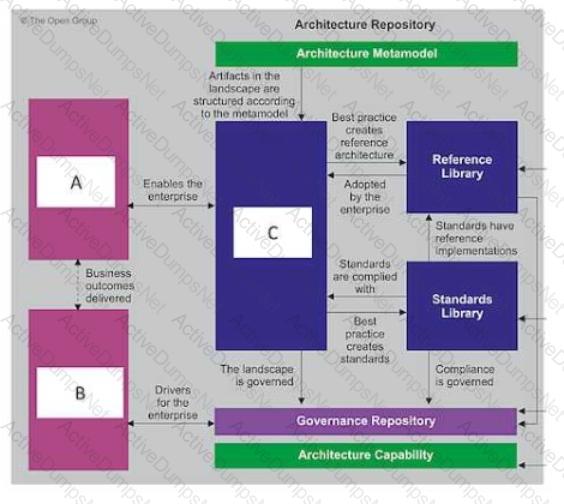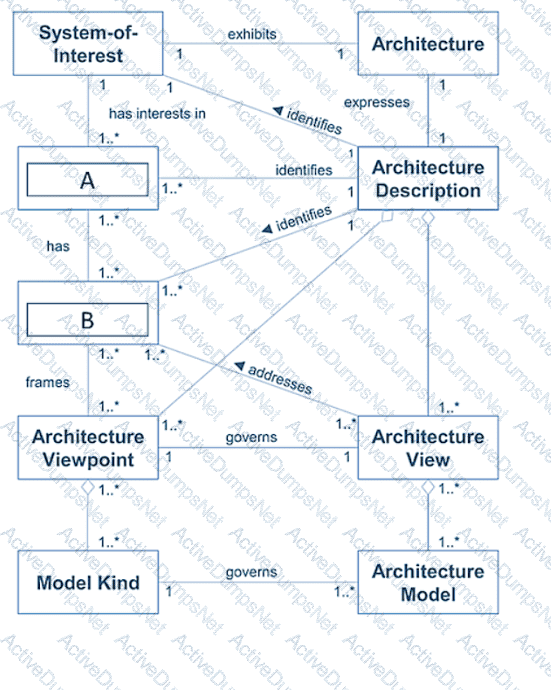Which of the following is a responsibility of an Architecture Board?
When considering Architecture Governance, what is the benefit that derives from discipline?
Complete the sentence. Actions arising from the Business Transformation Readiness Assessment technique should be incorporated in the
What should be put in place through organization structures, roles, responsibilities, skills and processes to carry out architectural activity effectively?
Consider the following statements about Architecture Partitioning:
The TOGAF ADM requires a partitioning model for architecture development
Architectures are partitioned when different teams need to work on different elements of the architecture at the same time
Partitions can be used to facilitate architecture re-use
Which statements are correct?
Complete the sentence. A business scenario describes
The_________________ensures that a project transitioning into implementation also smoothly transitions into appropriate Architecture Governance.
What information does the Architecture Requirements Repository within the Architecture Repository hold?
Consider the following statements
1 A whole corporation or a division of a corporation
2 A government agency or a single government department
3 Partnerships and alliances of businesses working together such as a consortium or supply chain
What are those examples of according to the TOGAF Standard?
Which phase of the ADM has the purpose to develop an Enterprise Architecture Capability?
Consider the following ADM phases objectives:
Ensure that the business value and cost of work packages and Transition Architectures is understood by key stakeholders
Ensure conformance with the Target Architecture by implementation projects
Ensure that the architecture development cycle is maintained
Ensure that the Architecture Governance Framework is executed
Which phase does each objective match?
In which phase of the ADM cycle do building blocks become implementation-specific?
Complete the following sentence. In the ADM, documents which are under development and have not undergone any formal review and approval process are _________
Refer to the table below:

Which ADM Phase does this describe?
Which of the following is a purpose of creating a set of Architecture Principles?
Complete the sentence. Risks are identified as part of:

Consider the illustration of an architecture development cycle.
Select the correct phase names corresponding to the labels 1, 2 and 3?
Which of the following supports the need to govern Enterprise Architecture?
Consider the following descriptions of deliverables consumed and produced across the TOGAF ADM cycle.
General rules and guidelines, intended to be enduring and seldom
amended, that inform and support the way in which an organization sets
about fulfilling its mission
The joint agreements between development partners and sponsors on the
deliverables, quality, and fitness-for-purpose of an architecture.
A document that is sent from the sponsoring organization to the
architecture organization to trigger the start of an architecture
development cycle
A set of quantitative statements that outline what an implementation
project must do in order to comply with the architecture.
Which deliverables match these descriptions?
1 Architecture Principles -2 Architecture Contracts - 3 Request for Architecture Work - 4 Architecture Requirements Specification
1 Architecture Contracts - 2 Architecture Requirements Specification - 3 Architecture Vision - 4 Architecture Principles
1 Architecture Requirements Specification -2 Architecture Principles - 3 Architecture Vision - 4 Architecture Contracts
Consider the following statements.
1. All processes, decision-making, and mechanisms used will be established so as to minimize or avoid potential conflicts of interest.
2. More effective strategic decision-making will be made by C-Level executives and business leaders.
3. All actions implemented and their decision support will be available for inspection by authorized organization and provider parties.
4. Digital Transformation and operations will be more effective and efficient.
Which statements highlight the value and necessity for Architecture Governance to be adopted within organizations?
Complete the following sentence. In the ADM documents which are under development and have not undergone any formal review and approval process are_______________.
Consider the illustration.

What are the items labelled A B and C?
Complete the sentence. Architecture effort at the Logical abstraction level is about:
Which of the following statements about architecture partitioning are correct*?
1 Partitions are used to simplify the management of the Enterprise Architecture
2 Partitions are equivalent to architecture levels
3 Partitions enable different teams to work on different element of the architecture at the same time.
4 Partitions reflect the organization's structure
Complete the sentence A business scenario describes______________
Complete the sentence. The purpose of Enterprise Architecture is to
Complete the sentence The Architecture Landscape is divided into levels known as__________________________.
Which of the following does the TOGAF standard describe as a package of functionality defined to meet business needs across an organization?
Which of the following is included as part of Architecture Governance1?
How does an Enterprise (Architecture) Metamodel provide value?
Which of the following are the four purposes that typically frame the planning horizon, depth and breadth of an Architecture Project, and the contents of the EA Repository-?
Complete the sentence. A business scenario describes:
Exhibit:

Consider the image showing basic architectural concepts.
What are items A and B?
Which ADM Phase provides architectural oversight of the implementation?
Complete the sentence Business Transformation Readiness Assessment is_________________.
Consider the following ADM phases objectives.
Objective:
1.Develop the Target Data Architecture that enables the Business Architecture and the Architecture Vision
2.Develop the Target Business Architecture that describes how the enterprise needs to operate to achieve the business goals
3.Develop a high-level aspirational vision of the capabilities and business value to be delivered as a result of the proposed Enterprise Architecture
4.Identify candidate Architecture Roadmap components based upon gaps between the Baseline and Target Technology Architectures
Which phase does each objective match?
Consider the following extract of the purpose of an ADM Phase:
Phase Output & Outcome / Essential Knowledge
? — “A set of work packages that address the set of gaps, with an indication of value produced and effort required, and dependencies between the work packages to reach the adjusted target.”
What ADM Phase is this?
Complete the sentence The Enterprise Continuum provides methods for classifying architecture artifacts as they evolve from________________________.
Complete the following sentence. In the ADM, documents which are under development and have not undergone any formal review and approval process are called______ Documents which have been reviewed and approved are called ______
Which of the following statements about architecture partitioning is correct?